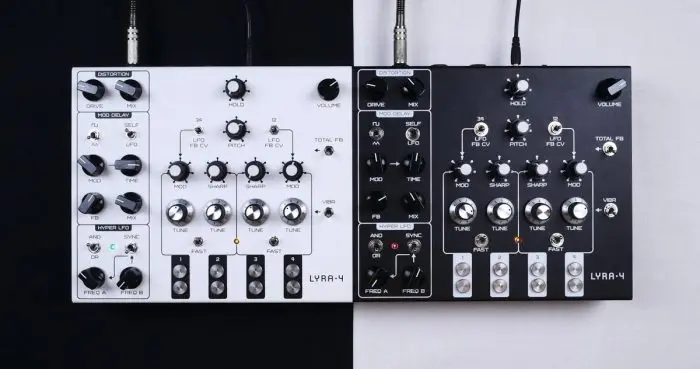SOMA Laboratory has announced that it has revived the younger sister of the famous LYRA-8. Built in a lighter, compact form factor, LYRA-4 packs a punch with four voices that can function in either electronic organ mode or FM synthesis mode, yielding a wide range of both experimental and traditional sounds.
Organismic and interactive
“Organismic” means that LYRA uses some principles that lie in the base of living organisms. The way that LYRA’s modules interact with each other and the overall behavior of the instrument resembles a live conversation. Despite its experimental character, LYRA-4 is a professional grade instrument that can be used to create a range of unique soundscapes. It is equally suited for live performance or studio recording without any additional processing.
Sonically, LYRA-4 is based on four generators, which can also be referred to as voices. Instead of having a linear or logarithmic dependency on control voltage like a traditional subtractive synthesis VCO, LYRA-4’s voices resemble the tone generators found in old electric organs, and each of the voices are constructed in such a way that allows for non-linearity to express itself. In terms of sound character, two LYRA-4s can actually sound very different than just one LYRA-8, as illustrated in the video below.
Two modes of synthesis: electric organ and FM synthesis
The voices — which can function either in electric organ or in FM synthesis mode — are divided into two pairs, creating tree-like structure. While in FM synthesis mode, each of LYRA-4’s voices and envelope are able to act as a separate FM operator, with each voice’s impact on FM synthesis decreasing with the decay of its envelope.
I addition to having four voices, LYRA-4 also features HYPER LFO: a complex low-frequency generator whose waveform is synthesized by summing or multiplying of the frequencies of two simple LFOs The LFO can modulate the selected pairs of voices and the MOD DELAY, as below.
The MOD DELAY imparts classic FX that LYRA is known for, consisting of delay with feedback. The delay imparts a unique sound character in that it can self-modulate, and the output signal is able to modulate the delay sample rate, resulting in unusual and cool effects. Finally, the DISTORTION control is last in the chain following the delay. This enables the delay to also influence impact of the distortion.
Priced at 360 EUR and available in either black or white, LYRA-4 is built in a robust enclosure which fits easily into a backpack for convenient travel. For a limited time, SOMA Europe is offering a special launch price for two LYRA-4s – which when used together can impart a magical stereo image, each LYRA with its own effects.
More information: SOMA Laboratory
 Save big with Plugin Boutique's Drums, Percussion & Rhythm Month Sale!
Save big with Plugin Boutique's Drums, Percussion & Rhythm Month Sale!

